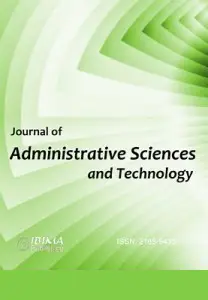Introduction
The term “career” has many different definitions and meanings, but no universally accepted definition can be found. Indeed, the lack of conceptual clarity contributes to the persistence of ambiguity and the inability to establish a common foundation of thought in the field (Patton & McMahon, 2014, p. 4).
According to the researcher (Zlate, 2004, p. 349), “Careers and career management are the most important human resources issues facing organizations today.” Traditionally, the concept of career was understood as the promotion of a person to a higher position with the purpose of acquiring money, prestige, or power (Ivancevich & Glueck, 1986, p. 521), but gradually its scope of application expanded. Therefore, the term “career” refers not only to vertical, but also to horizontal growth through further development of the individual within the position. Therefore, over time, after developing or mastering new skills, a person may take on new tasks of higher levels of difficulty.
One can easily notice that traditional definitions of career limited the term to a professional life referring only to employees’ career advancement process, without taking into consideration pre-vocational, post-vocational activities or other specific roles and particular life contexts. Other researchers (Arthur et al., 1989, p. 8) described the term career as “the evolving sequence of a person’s work experiences over time”. It can be also understood as the individual’s occupational identity (Androniceanu, 2003, p. 149).
Definitions also draw attention to another concept, namely, career development. It was described for the first time in 1951 by several experts in the field (e.g. Ginzberg et al., 1951). According to the initial theory, the process was considered completed at the beginning of adulthood, but the theory was later revised, being considered a process that takes place over several years (Ali & Anwar, 2021). The importance of recognizing career development can be summarized in the following definition: “Career development is the total constellation of psychological, sociological, educational, physical, economic and chance factors that combine to shape the career of an individual over the life span” (Sears, 1982, p. 139).
More recent research includes broader notions within the concept of career development. Thus, according to Brown & Lent (2013, p.10), “Career development […] connotes a continuous stream of career-relevant events that are not necessarily linear or positive in impact and that may or may not be subject to a personal agency (e.g., being born into poverty, losing a job due to the bankruptcy of one’s company”. Moreover, Alberta Career Development Association (2012) stated that career development represents “the lifelong process of managing learning, work, leisure, and transitions to move toward a personally determined and evolving preferred future”. The specialists are trying to distinguish between the objective career which refers to the development of the staff and the possibility of their promotion and the subjective career which refers to the way an individual perceives himself and the work he performs.
Regarding establishing the career of a person along one’s life, single or multiple careers can exist. Thompson et al. (1986) recommend an evaluation model and career analysis in four successive stages:
- The initial or debut stage in which the person works under the coordination of a mentor and he/she is a trainee;
- The stage in which one relies less on his/her mentor develops credibility, and reputation and carries out independent work that can produce significant results, being an independent contributor;
- The third stage is the expansion of skills, the possibility of becoming a leader or mentor;
- The last stage can be considered a stage of full maturity, in which, in addition to executing complex works, one can influence decision-making processes, establish strategies and allocate resources, and represent the organization, practically the person can be an influencer at the organizational level.
Each stage has different terms, depending from one person to another. Some people do not reach all stages. Regarding the evolution of people’s needs and their correlation with the stages of professional career, it can be mentioned (Burlea-Schiopoiu & Remme, 2017):
- Pre-work – main objectives are job security, security or psychological needs;
- Stability – in which the major needs relate to job security and security;
- Advancement – the predominant needs are self-realization, esteem, autonomy, or job security;
- Maintenance – the main objective is esteem;
- Retirement – the need for self-realization is predominantly manifested.
The process of career organization and development is a complex one, which depends on both objective and subjective factors, on internal and external factors, regardless of whether the sector of activity in which the person carries out his/her activity is public or private. An individual’s career is influenced by a multitude of direct and indirect factors, such as motivation, personal interests, group of friends, demand on the labor market, etc. (Babeș-Bolyai University, 2021).
Starting from the aforementioned theoretical aspects, the present study is based on an analysis regarding civil servants’ career development in the public administration of Romania towards public management positions or high-ranking civil servants.
The article is divided into three chapters. The first one approaches theoretical aspects regarding civil servants’ career development system in Romania. The second chapter is dedicated to the research methodology. The last chapter presents the results of the conducted study regarding the vertical career development of civil servants. The research ends with conclusions.
Career development in the Romanian civil service
According to the data provided by the Ministry of Finance, at the end of 2022, in the Romanian public sector worked 1,267,973 million people. Out of them, 176,471 were civil servant positions, out of which 135,510 were occupied, 3,894 temporarily occupied, 7,027 temporarily vacant public positions and 30,040 vacant public positions (National Agency of Civil Servants, 2023a). Thus, the percentage of civil servants in the total staff paid from public funds was 11%.
“Civil service has represented, over time, one of the institutions with which Romanian administration and the state, as a whole, have been identified” (Vedinas, 2020). The role of the civil servant in the architecture of the Romanian public administration was and still is very important. Being a civil servant was considered a true title of nobility in the 19th century.
In Romania, career management in public service is ensured by (Romanian Government, 2019):
- The National Agency of Public Servants (NACS) which elaborates on the tools regarding planning, organization and career development;
- Public authorities or institutions through the development of policies and internal instruments for managing human resources and ensuring transparency;
- The public servant, through the continuous improvement of performance and the development of new skills and competencies.
According to the current Romanian legislation (Romanian Government, 2019), the civil servant is the person who carries out his/her activity within a public authority or institution, based on a service report and fulfills the prerogatives of public power (elaboration of draft normative acts or public policy proposals, management of resources human resources and public funds, authorization, inspection, control, and public audit, etc.).
Civil servants’ career development involves a multitude of activities carried out, first of all, individually, but also by the human resources structures and the hierarchical superiors. The process of career development in public service can be carried out both horizontally by promotion to a higher professional degree or promotion in class, but also vertically, by occupying a public management position or in the category of high-ranking civil servants (Romanian Government, 2019).
A career in a public position implies elements of organizational nature, such as missions, objectives, and activities, as well as elements of individual nature, such as the resources included in public organization, highlighted by competencies, abilities, or skills (Bercu, 2009, p. 199). The essential characteristics of a public function can be expressed by two key concepts: stability and continuity. Stability means the development of the civil servant’s career, from recruitment to the end of his/her professional activity. Continuity refers to the possibility the civil servant has to either follow a career in the public administration field, in the same position he/she was hired for, or to advance in his/her career, as a result of being promoted to a management position (Mihai et al., 2017).
Within the Romanian administrative system, public management positions (GEO no. 57/2019, art. 390) are: head of office, head of service, executive director, deputy director, director, deputy general director and general director, and in the category of high-ranking civil servants are included the following functions (art. 389): general secretary and deputy general secretary from public authorities and institutions, general secretary of the prefect’s institution and government inspector. Also, another public management function is that of the general secretary of the territorial administrative units (art. 242).
According to professor Vedinas (2021, p. 449), the right to civil servants’ career is a synthesis right that includes elements from all recognized rights of a civil servant. In order to develop their careers, civil servants must make a series of constant efforts, on several levels, that will contribute to professional development in the short, medium, and long term.
“Career development involves an extensive career management process and takes into account the evolution of civil servants within public institutions, according to their needs and performance, potential and aspirations” (Tomescu, 2020, p. 154). The legislation that regulates the organization and development of a civil servant’s career defines it as the set of legal situations and the produced effects, which take place from the date on which the service report of the official begins until the moment when it ceases (GD no. 611/2008, art. 2).
In the incidental legislation, civil servants’ career development is based on a series of principles (Government Decision no. 611/2008, art. 4), such as competence, competition, equal opportunities, professionalism, motivation, and transparency. These principles represent the main indicators regarding the career system in public service, from the recruitment process, performance of activities, and development of skills and competencies, up to promotion to a higher-level position. It is highly important for a civil servant to know his/her main professional goal and to set intermediate objectives throughout his/her career. Therefore, he/she must take into account both favorable and unfavorable situations that may appear spontaneously, at a certain moment, on his/her career path. Moreover, the civil servant must take his/her career development seriously and set the steps he/she needs to follow in this regard through concrete plans.
Another important aspect of career development is that of managerial skills, a sine qua non-condition especially for occupying management positions.
According to some studies (Rambol Management, p. 7), career development has three basic objectives:
- Meeting the human resource needs of public entities;
- Training and development of officials so that they can face any level of responsibility, provided that they have the capacity or potential in this regard;
- Supporting and guiding competitive officials both to achieve personal goals and to increase their contribution within the organization.
A very important pillar in civil servants’ career development is professional training in all its forms: initial, advanced, or specialized training. The training has as main purpose the professionalization and, implicitly, his/her professional performance. There are also specialized training programs dedicated to the development of certain skills necessary to exercise a public management position (National Institute of Administration, 2023).
Career development can be defined in terms of skills and official needs to perform tasks with a high degree of complexity and at the same time contribute to the development of the organization. These can be called competence intervals and according to an analysis previously carried out, three competence intervals were identified: interval 1 – which corresponds to basic training, interval 2 – additional training or improvement, and interval 3 – specialized training (Rambol Management, n.d., p. 12).
One of the main options for civil servants’ career development is promotion: in a professional degree, in class, in a management position, or as a high-ranking civil servant. In order to promote, civil servants must fulfill a series of requirements established by the legislation in force (Romanian Government, 2019). In order to receive a professional grade promotion, the civil servant must have at least three years of experience in the public position from which he/she is being promoted, he/she must have at least the mark “good” at the last two annual evaluations, he/she must have participated in a professional training program with a length of at least 30 hours in the last three years or have received 30 credits from participating in training programs or study visits and he/she must not have any indelible disciplinary sanction in his/her administrative record under the provisions of Law no. 188/1999 on the Civil Servants’ Statute.
In order to organize a class promotion exam, the following conditions must be met cumulatively: the civil servant must have a bachelor’s degree in the field he/she carries out his/her activity or in a field that is considered useful for carrying out the activity by the person who has the competence to appoint – the head of the public authority or institution and he/she must not have any indelible disciplinary sanction in his/her administrative record (Romanian Government, 2019).
We emphasize the fact that promotion in professional-grade and promotion in class are not conditioned by the existence of a vacancy, but only by the allocation of the necessary funds in the payroll budget provisions by the public institution that organizes the exam, as a result of the subsequent transformation of the position occupied by the civil servant.
Regarding the promotion to a public management position, the civil servant applying for such a position must meet a series of conditions such as (Romanian Government, 2019):
- To be appointed to a first-class public position;
- Seniority conditions in specialized studies necessary in order to exercise the public function, respectively: five years for the head of office, head of service, general secretary of the administrative unit, or other specific functions assimilated to them, seven years for occupying the other public management functions (deputy executive director, director executive, deputy director, director, deputy general director, general director, general secretary of the town hall, municipality, or county council);
- Fulfilling the study conditions or other specific conditions required;
- To obtain a master’s degree in the fields of public administration, management, or in the specialty of the studies necessary to exercise the public function;
- Not to have any disciplinary sanction, according to the provisions of the administrative code;
- To have participated in a professional training program with a minimum duration of 30 hours or to have obtained 30 credit points following participation in training programs, exchanges of experience, seminars, etc.
At this moment, the system of credits necessary to promote has been established by a Government Decision that is on the approval circuit, with a view to adoption.
To participate in an exam for the high-ranking civil servants’ category, the civil servant must meet the following requirements (GEO no. 57/2019, art. 394, art. 483):
- To be appointed to a first-class position;
- University graduate with a bachelor’s degree or equivalent;
- Graduate with a master’s degree in public administration, management or in the specialty of the studies necessary to exercise the public function;
- Experience of at least seven years in the specialty of the studies necessary to exercise the public function;
- Graduate of the specialized training program for the public office corresponding to the category of high-ranking civil servants organized by the national institute of administration or to have had a full mandate as a parliamentarian;
- Not to have any disciplinary sanction;
- To promote the exam organized by NACS for the public office positions (Geo no. 57/2019, art. 467).
Most high-ranking civil servants hold their public positions either by secondment or temporary assignment thus generating a series of negative consequences for this working category. The category of high-ranking civil servants was created to ensure the high-level management and the continuity of these particular positions in the public authorities and institutions where they are to be found, either at the central or the local level. The exception that has become the rule can lead to the deprofessionalization of this category, to the lack of stability and continuity, and to a possible threat to the civil servants’ political neutrality.
The temporary occupation of public management positions or in the high-ranking officials’ category represents a way of developing the career of public officials.
This can be done either by being seconded to another institution in order to exercise a management or high-ranking function (GEO no. 57.2019, art. 505) or by temporarily exercising one of the functions in the framework mentioned above in which the civil servant is employed.
Both in the case of secondment, as well as in the case of temporary exercise, the civil servant must fulfill the conditions of seniority and education. Moreover, in the case of secondment, it is necessary to fulfill the specific conditions of the named position, namely graduation from the specialized training program.
Through this type of temporary promotion, civil servants can develop their managerial skills, and acquire new skills representing a motivation through the recognition of merits and professional performances and a motivation through occupying a management position and an increase in income. As previously mentioned, the percentage of temporarily occupied management positions must be significantly lower than that of occupied ones, so that the decision-making process is not influenced by a series of subjective criteria, such as instability in these positions. At this moment, in Romania’s public administration, new methods of civil servants’ recruitment at the central level are being introduced, inspired by other models from European countries and adapted to the needs of career development of civil servants. In this sense, a pilot competition was organized between May and June 2023 by the National Agency of Civil Servants (2023b) for the recruitment of debutants and high-ranking civil servants (national competition, pilot project).
This new way of modern employment includes two stages:
- The recruitment stage at national level, in which the knowledge and general skills necessary to occupy the public position are verified by NACS through a general competition;
- The selection stage, which consists of verifying specific knowledge. An exam is organized by the authorities or institutions where the vacant positions exist.
The introduction of new modern methods regarding both recruitment and career development of civil servants, which can later be extended to all categories, contributes to the transparency and efficiency of the recruitment and selection process, so that the best-performing candidates are recruited, ones who contribute to improve the performance of public entities and the successful implementation of organizational processes (Habanik et al. 2020).
Research Methodology
The present study represents an exploratory research regarding the vertical career development of civil servants in Romanian administration through promotion in public management positions or in the category of high-ranking civil servants.
The study is based on a quantitative research method, namely the document analysis. As part of the document analysis process, data were collected and extracted from Reports of the National Agency of Civil Servants (2023) in Romania from 2020-2022, as well as other reports, studies or analyses posted on the Agency’s website and the websites of other government institutions. Moreover, an analysis of the applicable legislation to the public sector in general and public officials in particular was carried out, as well as on specialized literature, such as that which annotates the specific legislation.
The collected data were processed with the help of SPSS 26.0 software aiming to identify some factors that have an impact on the career development of the Romanian civil servants, to better understand the current situation, the evolution of the public function for certain categories of personnel and to identify possible solutions contributing to the improvement of career-related outcomes and career development paths.
The main results of the exploratory study

Fig. 1. The number of public positions in the Romanian public administration
Source: Authors’ own data processing after National Agency of Civil Servants’ data, 2023a
During 2020-2023, the number of public positions in Romania’s public administration experienced a slight increase, from 173.655 in 2020 to 176.471 in 2022, respectively by approximately 2% in 2022 compared to 2020. Considering the number of public institutions in NACS record, 4344 in 2022, respectively 4335 in 2021 (NACS, 2023a, p. 24), the increase is insignificant, one of the causes being the increase in the number of institutions, the reorganization processes taking place or organization of recruitment or promotion contests in public office.
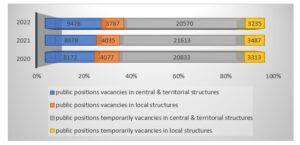
Fig 2. Total number of vacancies and temporary vacancies positions in central, territorial and local Romanian public administration
Source: Authors’ own data processing after National Agency of Civil Servants’ data, 2023
The above figure shows that the number of vacant public positions in central and territorial structures is lower (about 11%) than in local administration (about 20%). There is, however, a tendency of increase in the number of vacancies at the central and territorial levels, in contrast to the local level, where their number is decreasing.
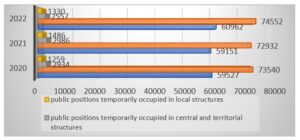
Fig 3. Distribution of public positions in central and local administration
Source: Authors’ own data processing after National Agency of Civil Servants’ data, 2023
According to the analyzed data, most of the held public positions are in local public administration structures (approximately 54%), most of them being at town halls and commune levels (NACS, 2023a, p. 30). This trend is maintained throughout the studied period (2020-2022). In Romania, at the local level, there are 3229 administrative territorial units, of which: 42 county councils, 109 municipalities, 217 cities, and 2861 communes (Ministry for Development, Public Works and Administration, 2023, p.7). At the central level, civil servants carry out their activities within the General Secretariat of the Government, the Chancellery of the Prime Minister, ministries, and into a number of government agencies. Although the number of institutions at the central level is significantly lower, they have complex organizational structures, with a large number of employees compared to the institutions at the local level.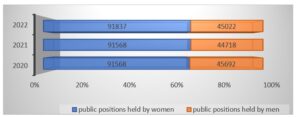
Fig 4. Total number of public positions held by women & total number of public positions held by men
Source: Authors’ own data processing after National Agency of Civil Servants’ data, 2023
According to the analyzed data, in the Romanian public administration, more than 2/3 of civil servants are women. More than that, out of all management positions, the majority are occupied by women (approximately 61.3%) and only 38.7% of them by men.
If women predominate middle management positions, in regards to higher management positions, such as high-ranking civil servants, the percentage of male population is 63.2% (NACS 2023a, pp. 40-41). Therefore, compared to the total number of women in public administration (approximately 65%), at higher management positions level, such as high-ranking civil servants, they are underrepresented. However, Romania adopted policies and laws aimed at promoting gender equality in various fields, including in public administration, recognizing the need to increase the participation of women in decision-making positions and in leadership positions in public administration.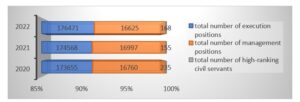
Fig 5. The distribution of the total number of public positions
Source: Authors’ own data processing after National Agency of Civil Servants’ data, 2023
Out of the total number of public positions, 11,20% represent the number of management positions, being in accordance with the legal provisions. Thus, according to art. 391 of the Administrative Code (Romanian Government, 2019), the total number of management positions, except secretaries of administrative-territorial units, is a maximum of 12% of the total number of approved positions. According to the graphs, we notice that the number of occupied management positions has remained relatively constant, this being explained through the concept of stability.
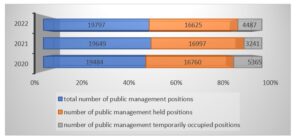 Fig 6. Public management positions
Fig 6. Public management positions
Source: Authors’ own data processing after National Agency of Civil Servants’ data, 2023
According to the analyzed data, during 2020-2022, there was a slight increase in the total number of public management positions, but the same increasing trend is not maintained when it comes to the occupational degree. The analyzed data show that the percentage of public management positions was held constant in 2020 and 2021 (approximately 86%).
At the same time, it can be observed that the largest number of public management positions occupied by temporary exercise was in 2020, with a decrease in 2021. This can be explained by the fact that in March 2020, in the Covid Pandemic -19 context, a state of emergency was declared on the territory of Romania and subsequently a state of alert (Law no. 55/2020). The increase in the number of temporary management positions from 2022 can be explained by the fact that, in 2022, the government authorities ordered the suspension of the organization of recruitment contests for public positions (GEO no. 80/2022).
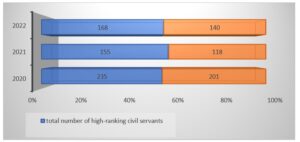
Fig 7. The number of public positions corresponding to the category of high-ranking civil servants
Source: Authors’ own data processing after National Agency of Civil Servants’ data, 2023
The figure above shows a decrease in the total number of high-ranking civil servants’ positions in public administration, as well as a slight decrease in the number of total occupied positions. The total number of high-ranking civil service positions is less than about 30%. The largest decrease in the number of positions in the category of high-ranking civil servants was recorded in 2021. This is explained by the fact that legislative changes took place, in the sense that the positions of prefect and sub-prefect were removed from the category of high-ranking civil servants and became functions of public dignity, returning to the situation before Romania acceded to the European Union. By the same normative act, the position of general secretary of the prefect’s institution was reintroduced, a public position in the category of high-ranking civil servants, with the role of ensuring stability at the institutional level (GEO no. 4/2021).
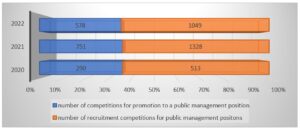
Fig 8. The number of competitions for a public management position promotion
Source: Authors’ own data processing after National Agency of Civil Servants’ data, 2023
In 2020-2022, the number of management positions for which a promotion competition was organized was 1619. The largest number of competitions organized for promotion to a public management position was in 2021. This fact is explained by the fact that in 2020 the authorities ordered restrictive and quarantine measures in order to reduce the risk of the spread of the COVID-19 virus, and the decrease from 2022 compared to 2021 can be explained by the adoption of a normative act suspending the organization of contests for holding public positions.
However, it can be observed that the percentage of management positions put up for competition through recruitment is approximately 40% higher than the positions put out through promotion, the system being open also for people working in the private sector or for contract staff within public authorities or institutions.
Conclusions
Taking into account the analyses carried out as part of this study, on both the Romanian legislation and the data collected from official reports regarding the system of promotion to a managerial position, in particular, we can observe a number of shortcomings, such as: promotion as a result of the temporary exercise of the public function in the case of high-ranking civil servants (83,33%) and not as a consequence of the detachment of high-ranking civil servants who obtained the position as a result of a competition.
Also, the legislative framework concerning the recruitment and promotion system for both managerial and executive public positions is subject to amendments and it will be completed. These legislative changes will contribute to increasing transparency, as well as modernizing and streamlining the access to civil service, through the use of modern tools, similar to those used in other EU countries. Regarding administrative practices in Romania, we believe that many improvements are needed, both in terms of the recruitment and promotion system and the career development of civil servants, especially since senior civil servants play an important role in the management and implementation of public policies and services.
Mentoring activities, the development of a career plan, and concerns of the organization’s management for staff training are essential factors for the development of the human resources potential within the public administration.
The development of professional strategies in the field of human resources is essential in attracting competent personnel. More than that, tool development in the human resources field that is able to modify and complete the current legislation, in order to build a high-performing public administration is needed. It is very important that at each public organization level, a workforce planning process is designed to meet future needs in terms of human resources.
Professional training is also one of the pillars of career development. A well-trained human resource is efficient and can contribute to organizational development and to the successful implementation of reform processes. Professional training programs must be correctly identified following the evaluation of annual professional performances, and participation must create added value both for the student and for the organization from which he or she comes.
The pilot project for new recruitment methods for certain categories of public functions, carried out by NACS in 2023, represents a first step in the efficiency and greater transparency of the public function access process. According to milestone 417 of Romania’s National Recovery and Resilience Plan, recruitment will be extended to other socio-professional categories – there will be at least 3 different categories, which will lead to the general modernization and to a higher transparency of the selection process for both managerial and executive public positions.
Therefore, strategic planning of human resources and the development of appropriate tools can contribute to attracting competent personnel from external sources, as well as to the promotion of competent officials, building a high-performing public administration adapted to the needs and requirements of Romanian society.
The present study can be extended to the level of each category of public management position, as well as to each category of high-ranking civil servants so that the results obtained regarding the promotion of public officials in management or high-ranking positions provide relevant information regarding the system of civil servants’ career in Romania. Furthermore, it represents the base for improved policies and practices in this field implementation.
References
- Ali, B.J. & Anwar, G. (2021). An Empirical Study of Employees’ Motivation and its Influence Job Satisfaction. International journal of Engineering, Business and Management (IJEBM), 5(2). https://dx.doi.org/10.22161/ijebm.5.2.3
- Androniceanu, A. (2003). Noutăți în managementul resurselor umane. București: Editura Economică.
- Arthur, M.B., Hall, D.T. & Lawrence, B.S. (Eds.) (1989). Handbook of career theory. Cambridge: Cambridge University Press.
- Babeș-Bolyai University, (2021), Mituri despre cariera. Available at: https://consilierecariera.ubbcluj.ro/2021/09/15/mituri-despre-cariera/.
- Bercu, A.M. (2009). Pregătirea profesională și cariera personalului din administrația publică. București: Editura Universitară.
- Brown, S. & Lent R. (2013). Career development and Counseling. Puting Theory and Research to work (2nd edition). New Jersey: John Wiley & Sons Inc.
- Burlea-Schiopoiu, A. & Remme J. (2017), The Dangers of Dispersal of Responsibilities. Amfiteatru Economic, 19(45), pp. 464-476
- Career Development Association of Alberta. (2012). What is Career Development? Available at: https://www.careerdevelopment.ab.ca/whatiscd.
- Ginzberg, E., Ginsburg, S.W., Axelrad, S. & Herma, J. L. (1951). Occupational Choice: An Approach to a General Theory. New York: Columbia University
- Habanik, J., Martosova, A. and Letkova, N. (2020). The impact of managerial decision-making on employee motivation in manufacturing companies. Journal of Competitiveness, 2(2), pp. 38-50
- Ivancevich, J.M. & Glueck, W.F. (1986). Foundations of personnel/Human Resorce Management. Texas: Business Publications Inc.
- Ministry for Development, Public Works and Administration (2023). Indexul integrității în administrația publică locală. Available at: https://www.mdlpa.ro/uploads/articole/attachments/6486edd96c223473418114.pdf.
- Mihai, L.S., Burlea-Schiopoiu, A. & Mihai, M. (2017), Comparison of the leadership styles practiced by Romanian and Dutch SME owners, International Journal of Organizational Leadership, 6(1): 4-16, doi: 10.19236/IJOL.2017.01.01
- National Agency of Civil Servants (2023a). Raport privind managementul functiilor publice si al functionarilor publici pentru anul 2022. Available at: https://www.anfp.gov.ro/R/Doc/2023/Rapoarte/1_Raport%20Mangementul%20Functiei%20Publice%202022_30.05.2023.pdf.
- National Agency of Civil Servants (2023b). Concurs național – Proiect pilot. Available at: https://www.anfp.gov.ro/continut/Concurs_national__Proiect_pilot.
- National Institute of Administration (2023). Programul de formare specializată pentru funcțiile de conducere din sectorul public. Available at: https://ina.gov.ro/pfc2023/.
- Parliament of Romania (2020). Law no. 55/2020 on some measures to prevent and combat the effects of the COVID-19 pandemic, published in the Official Journal of Romania no. 396 from May 15, 2020.
- Patton, W. & McMahon, M. (2014). Carrer Development and Systems Theory (3rd edition). Rotherdam: Sense Publishers.
- Ramboll Management (n.d.). Ghid privind dezvoltarea carierei. Available at: https://www.anfp.gov.ro/R/Doc/2015/Proiecte/Incheiate/PHARE%20RO%2001.06.04/Ghid%20privind%20dezvoltarea%20carierei%20functionarilor%20publici%2017022015_104300.pdf.
- Romanian Governement (2008). Government Decision no. 611/2008 approving the rules on the organization and career development of civil servants, published in the Official Journal of Romania no. 530 from July 14, 2008.
- Romanian Government (2019). Government Emergency Ordinance no. 57/2019 on the Administrative code, published in the Official Journal of Romania no. 555 from July 5, 2019.
- Romanian Government (2020). Government Emergency Ordinance no. 80/2022 on the regulation of measures in the field of employment in the budgetary sector, published in the Official Journal of Romania no. 593 from June 17, 2020.
- Romanian Government (2021). Government Emergency Ordinance no. 4/2021 for amending and supplementing Government Emergency Ordinance no. 57/2019 on the Administrative code, published in the Official Journal of Romania no. 117 from February 3, 2021.
- Sears, S. (1982) A Definition of Career Guidance Terms: A National Vocational Guidance Association Perspective. Quarterly, 31(2), pp.137–143.
- Thompson, P., Baker, R.Z. & Smallwood, N. (1986). Improving professional development by applying the four-stage career model. Organizational Dynamics, 15(2), pp. 49-62.
- Tomescu, M. (2020). Management public (ed. a II-a). București: Editura Pro Universitaria.
- Vedinaș, V. (2020). Funcția publică în România: evoluție legislativă și practici instituționale. Revista de drept public (Universul Juridic), 3. Available at: https://lege5.ro/gratuit/g4ytomjshe3q/functia-publica-in-romania-evolutie-legislativa-si-practici-institutionale-public-office-in-romania-legislative-development-and-institutional-practices.
- Vedinaș, V. (2021). Codul administrativ adnotat (ed. a III-a). București, Editura Univers Juridic.
- Zlate, M. (2004). Tratat de psihologie organizațional-managerială. Iași: Editura Polirom.



